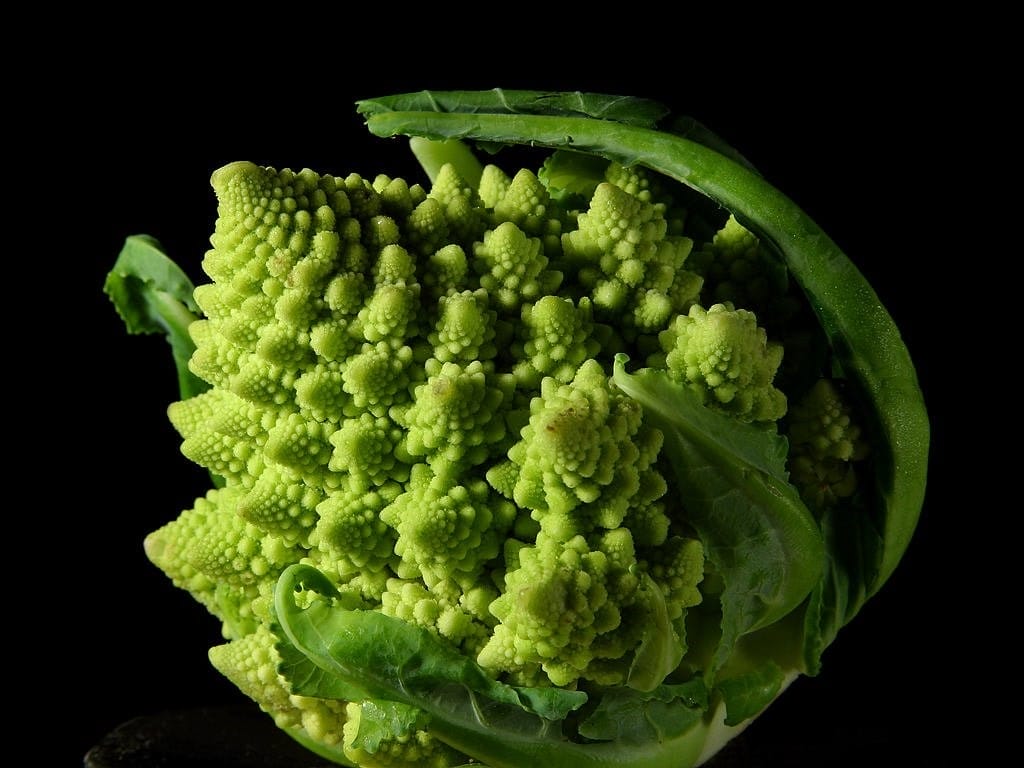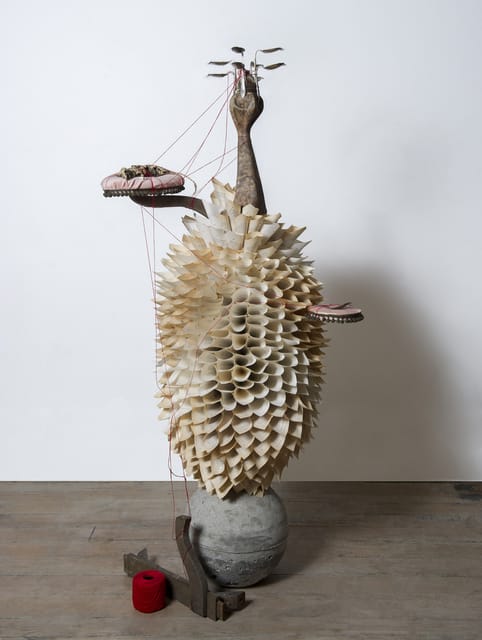Mimicking nature in pattern and growth: The fascinating atmosphere of repetition and accumulation in Samuelle Green’s work
Soft concretions of repeated elements creep onto old objects, on gallery walls, on parts of an architecture, … these shapes take over the space, hiding and revealing surfaces and volumes, creating an immersive atmosphere.
When approaching Green’s artwork, the viewer is surprised by a sudden sense of curiosity. It feels like the human mind is familiar with the ultra-detailed surfaces it encounters.
The reason of this primitive attraction can be found in our daily life. For example: on a winter day, at a market stall, among the subtle shades of green of the winter veggies we can’t but notice the exuberant shapes of a Roman Broccoli. In its beauty and detailed perfection, this vegetable reminds us how nature grows, how complex shapes develop from small elements repeating infinitely on different scales.
Online, available at: https://pxhere.com/es/photo/1158679
If we zoom in on a single part of its surface, as in a single part of Green’s artwork, we will get an image very similar to the original one. Mandelbrot explained this phenomena with his theory on fractal geometry ( 1975 da Benoît Mandelbrot in Les Objets Fractals: Forme, Hasard et Dimension) With his definition, he gave order to the apparent baroque recklessness of those forms with chaotic behavior, which are so attractive because of their complexity. These scales of growth echo all around us from micro to macro cosmos, attracting our attention and leaving us with a sense of surprise while we recognize how familiar they are.
According to a scientific research from 2007, about the human response to this kind of natural shapes: “Through exposure to nature’s fractal scenery, people’s visual systems have adapted to efficiently process fractals with ease. This adaptation occurs at many levels of the visual system, from the way our eyes move to which regions of the brain get activated. This fluency puts us in a comfort zone and so we enjoy looking at fractals.”[1]
When it comes to Green’s art practice, the kinship with nature and its shapes is deeply rooted in her childhood, spent in the open spaces of rural Pennsylvania. The everyday engagement has made her sensible to natural shapes and has thought her how to carefully pay attention to small details of the fascinating environment that surrounds us.
[1]Taylor, R. in ‘The conversation’ available at: https://theconversation.com/fractal-patterns-in-nature-and-art-are-aesthetically-pleasing-and-stress-reducing-73255
To the very end, copyright Samuelle Green
Samuelle says: “Being exposed to nature and natural habitats was an everyday occurrence. I always took notice of the small structures and textures in flora, bugs, birds, hives, nests, and animals. These same forms reveal themselves in so many areas of the natural world and these same forms are found everywhere from microscopic cellular structures to the largest architectural accomplishments of humans.”
If we think at nature as a giant dedicated craftsman, we will see it busy in an endless process of putting together equal elements over and over again. Samuelle proceeds in the same way when creating her works. She begins from a simple module: a cone, and expands by repetition, assembling one piece after another, using the physical characteristics of the material she prefers: paper.
Even if rigid, this material holds a certain degree of malleability: it is flexible, it can be easily twisted and turned, cut, glued, etc… If folded, paper is perfect to create three-dimensional shapes, like in the Japanese origami tradition.
Underbelly, copyright Samuelle Green
Samuelle chooses to use mostly recycled paper. Found in old dusty library, landfill or second-hand shops, old books are precious material for the artist. From the palette of yellow, beige, okra and through the ageing inks, hidden stories come forward.
Books hold the memories of their use. That’s one of the reasons why recycled materials are so special for the creator: they carry stories, they convey deeper meanings: they have agency. Several artists have a deep, visceral bond with the materials they choose to make work with. They are deeply attracted to them, to the point of feeling a kind of call.
Jane Bennet give us an account of this material call in her book Vibrant Matter: A Political Ecology of Things. (2010) Durham, North Carolina: Duke University Press.
Samuelle is familiar with Bennet’s theory when she explains: “There are materials and objects that call out to me and materials and objects that call out to each other. It is like they have been waiting to be united in some form. I am often drawn to the broken and discarded, the things that were once used and loved then tossed aside. “
The use of discarded materials, available in huge quantity, allow the artists to reach immersive dimensions with her projects and moreover to comment on important environmental issues like overconsumption and overproduction of goods in our society.
Discarded objects are also found in her sculptural production, where the modular paper technique adapts to a smaller scale and it is combined with broken or forgotten objects, loved and abandoned ones. According to Green: “Combining these objects that hold so much personality with other materials breathes a new and different life into them.”
Velvet slipper, copyright Samuelle Green
Her sculptural practice often accommodates the use of different kind of textiles, among others, velvet. The variety of textures created by combining soft materials, paper and wood is something the artist loves exploring.
“Soft upholstered bases holding up rigid structures is something you will be seeing more of in my sculptures. It creates a different sense of balance and strength between the materials”
In certain sculptures, the use of threads appears, a delicate signature we can find in many of Samuelle’s work. “I’m not certain why I’m drawn to them but they began to appear in a series of paintings about 25 years ago and continue to make appearances throughout my work. They seem to be a thread that holds things together in space and time. It ties together the old and new and joins the unites the materials that were seeking each other out. Throughout all of my work: painting, drawing, sculpture and installation there is a common thread of subject, human made object being met with elements from nature. Sometimes the interaction between the two and sometimes discord between them”

Shanghai manifestation, copyright Samuelle Green
For Green, the choice of material is crucial, as very important is the process applied onto materials while transforming them in a work of art.
The repetitive gesture of rolling the cones of paper carries the artist into a meditative state.
The Paper Caves, copyright Samuelle Green
“Hours if not days can pass without me taking much notice. There’s a specific amount of attention one needs to pay to the process to keep the size and shape consistent and the proper colour selection in mind but at some point, muscle memory takes over and allows me to consider the prospect of the piece growing into new and interesting projects”
Her shapes, that seems to be growing out of and unconscious process, made out of accumulation and repeated gestures, can be seen as a result of an instinctive action, where the artist chooses to prioritize intuitive and emotive experiences over reasoned interpretation. This process is instead controlled and defined inside her head. Her sculptural forms only have to be shaped until they overlap with their mental image.
The same kind of repetitive, meditative process of making can be found in the intricacy of weft and warp, in a crochet chain or in a needle work. It is a constituent part of the construction of cloth.
Samuelle compares the process of creating an installation with paper to the process of weaving and stitching pieces together. She has a background in textiles and takes from this to create certain aspects and approaches to the process.
“The way the armature is built using swags and tucking to create dimension are certainly related to draping fabric. I’ve also drawn on skills I learned from sewing and pattern making to create different three-dimensional shapes in the work. Patterns are often made to cut the armature pieces into shapes that will create the three-dimensional wire form”
Expanding from sculpture to spatial dimensions, her installations respond to site and its features. Hundred of paper cones are insert and glued onto a metal wire mesh that becomes the structure of an extended soft surface creeping onto existing structures while transforming the spaces of the exhibition and linking back to nature and its forms.
Beijing manifestation, copyright Samuelle Green
Entering the space of these installations is a very engaging sensorial experience. “Along with the visual aspect there is often a subtle sonic element. The sound is intermittent and when it is silent the paper installation creates something akin to an anechoic chamber. The light changes throughout the day and creates different shadows and feelings in the work. Photographs of the work show one important element but being immersed in the work feels very different.”
In these very peculiar times, where the viewer cannot physically be inside an installation, we wonder how to approach an artwork that requires to be experienced from within, touched, listened to and smelled.
I’ve asked Samuelle to what extend this global situation affected her practice.
Being a very “hands-on person” she experienced great difficulties caused by the impossibility of travel and personally install her works. While her mobility is restrained her artworks are sent off to china and installed by skilled professionals.
Samuelle’s way of working is also adapting to the changing times:
“Lately I’ve been spending my time in the studio on smaller works. This somehow seems more appropriate for the time being. The small works are in many ways experiments for future large-scale installations.”
We look forward to the new developments in Samuelle green’s art practice and hopefully we’ll be able to see her in Europe next year. The artist is meant to participate and install a large piece for a site-specific symposium in the city of Kohila in Estonia. It would be wonderful to be physically immersed in one of her installations.






